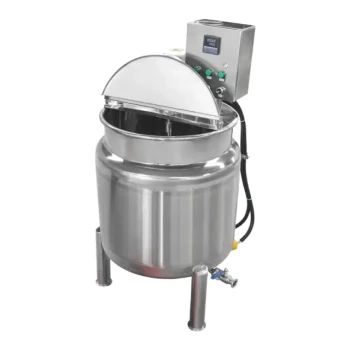Our honey heaters are essential for beekeepers and honey processing plants, designed to optimize honey quality and processing efficiency. The product range includes the Economy Honey Homogenizer Mixer and Melting Machine, ideal for small-scale beekeeping with a 120kg capacity and stainless steel construction. For larger operations, the 0.5T Capacity Honey Dehumidifier Dryer offers vacuum heating and thickening filtering capabilities. The Electric Double Wall Honey Filtering Machine ensures precise temperature control and dual filtration for superior honey purity. Additionally, the Silicone Rubber Honey Drum Heating Belt and Honey Tank Heater Drum Heating Blanket provide reliable solutions for maintaining honey fluidity and reducing crystallization. Our Stainless Steel Heated Honey Tank is perfect for precise temperature control and easy cleaning, making it a favorite among beekeepers.
Toggle Categories
Get Instant Support
Choose your preferred way to connect with our team
-
Get Free Quote Fill out form for detailed pricing
-
Send Email Detailed inquiry support
-
WhatsApp Quick mobile chat
Response Time
Within 8 hours on working days, 24 hours on holidays
honey heater

Economy Honey Homogenizer Mixer and Melting Machine for Beekeeping
Item Number : HM-1

Stainless Steel Heated Honey Tank Warming Heating Tank
Item Number : HHT-1

Honey Tank Heater Drum Heating Blanket for Honey Barrel
Item Number : HHT-2

Silicone Rubber Honey Drum Heating Belt
Item Number : HHT-3
Comprehensive Guide to Honey Heaters
Honey heaters are indispensable tools in the beekeeping and honey processing industry, designed to enhance the quality and efficiency of honey production. Our range of honey heaters includes various models tailored to meet the needs of both small-scale beekeepers and large honey processing plants.
Key Features and Benefits
-
Economy Honey Homogenizer Mixer and Melting Machine: This machine is perfect for small-scale beekeeping, featuring a 120kg capacity and stainless steel construction. It operates at a speed of 40r/min, ensuring efficient honey processing.
-
0.5T Capacity Honey Dehumidifier Dryer: Designed for larger operations, this machine offers vacuum heating and thickening filtering capabilities. It is built to be durable and compliant with industry standards, ensuring high-quality honey production.
-
Electric Double Wall Honey Filtering Machine: This machine is equipped with dual filtration and precise temperature control, making it ideal for achieving superior honey purity. Its 304 stainless steel construction ensures long-lasting durability.
-
Silicone Rubber Honey Drum Heating Belt: This heating belt is essential for reducing crystallization and maintaining honey fluidity. It is made from high-quality materials and offers adjustable temperature control, making it suitable for various honey processing needs.
-
Honey Tank Heater Drum Heating Blanket: With an average power of 220V and 400W, this heating blanket is perfect for liquefying crystallized honey in drums or barrels. It provides precise temperature control and ensures safe operation.
-
Stainless Steel Heated Honey Tank: This 70L tank features water-jacket heating and precise temperature control, making it easy to clean and ideal for beekeepers who require consistent honey quality.
How Honey Heaters Work
Honey heaters operate on the principle of controlled heating to maintain the desired temperature of honey, ensuring it remains in a liquid state and free from crystallization. The heating process can be achieved through various methods, including direct heating elements, water-jacket systems, and heating belts. These methods ensure that honey is processed efficiently without compromising its quality.
Advantages of Using Honey Heaters
- Efficiency: Honey heaters significantly reduce the time and effort required for honey processing, allowing beekeepers to focus on other aspects of their operations.
- Quality: By maintaining the optimal temperature, honey heaters ensure that the honey retains its natural flavor, aroma, and nutritional value.
- Versatility: Our honey heaters are designed to cater to different scales of operations, from small-scale beekeeping to large honey processing plants.
- Durability: Constructed from high-quality materials such as stainless steel and silicone rubber, our honey heaters are built to last, providing long-term reliability.
Customizable Solutions
We understand that every beekeeping operation is unique, which is why we offer customizable solutions to meet your specific needs. Whether you require a machine with a particular capacity, specific temperature control features, or a unique design, our team of experts is here to help. Contact us today to discuss your requirements and discover how we can tailor our honey heaters to your operation.
Why Choose Us?
Our commitment to quality and customer satisfaction sets us apart. We pride ourselves on providing high-performance honey heaters that are not only efficient but also easy to use and maintain. Our team of professionals is always available to offer guidance and support, ensuring that you get the most out of our products.
Get in Touch
Ready to enhance your honey processing with our top-quality honey heaters? We invite you to leave a message via our Contact Form to learn more about our products and services. Our team is eager to assist you in finding the perfect solution for your beekeeping needs. Don't wait—contact us today and take the first step towards optimizing your honey production!
FAQ
What Is The Principle Of A Honey Heater?
What Are The Advantages Of Using A Honey Heater?
What Are The Main Types Of Honey Heaters Available?
What Are The Applications Of Honey Heaters?
How Does A Honey Heating Belt Work?
What Is The Benefit Of Using A Stainless Steel Honey Heating Tank?
REQUEST A QUOTE
Our professional team will reply to you within one business day. Please feel free to contact us!
Related Articles

The Last Gate: Why a Simple Strainer Defines Honey Quality at Any Scale
Discover why the humble honey strainer is a non-negotiable tool for beekeepers, ensuring honey purity and quality at every scale of operation.

The Hidden Threat After Harvest: Why a Simple Lid Prevents Apiary Disaster
Discover how failing to replace honey container lids immediately after harvest triggers devastating "honey robbing," leading to colony collapse and disease spread, and learn how HONESTBEE's secure equipment protects your apiary.

How to Melt Beeswax Safely: Science-Backed Protocols to Prevent Overheating and Fires
Learn science-backed methods to melt beeswax safely, prevent overheating, and handle emergencies. Essential for candle makers and beekeepers.

The Last Drop: Maximizing Yield and Purity with a Stainless Steel Honey Press
A honey press isn't just an extractor; it's a tool to reclaim value from wax cappings, ensuring purity with food-grade steel and solder-free welds.

Mastering the Craft: A Professional's Guide to Calibrating Your Honey Refractometer

How to Optimize Queen Excluder Placement for Healthier Hives and Higher Honey Yields
Learn how to optimize queen excluder placement for healthier hives and higher honey yields with expert beekeeping tips.

How to Harvest Honeycombs Efficiently Without Compromising Quality or Bee Health
Learn efficient honeycomb harvesting techniques that maximize yield while ensuring bee health and honey quality. Essential guide for beekeepers.

How to Optimize Steam Wax Melting for Higher Yields and Safer Operations
Learn professional techniques to optimize steam wax melting for higher yields, safety, and equipment longevity in beekeeping operations.

How to Optimize Industrial Beeswax Melting: Key Parameters for Quality & Efficiency
Learn key parameters for industrial beeswax melting—temperature control, equipment selection, and best practices for quality & efficiency.

How to Scale Honey Supers Strategically: A Beginner’s Timing and Capacity Guide
Learn when to add honey supers to optimize hive space and honey yields. Key tips for beginners on timing, capacity, and avoiding common mistakes.

How Oxalic Acid Vaporization Safely Controls Mites While Protecting Bees
Oxalic acid vaporization safely controls Varroa mites while protecting bees and honey quality. Learn sustainable mite management for apiaries.

How to Choose a Honey Filling Machine: Balancing Efficiency, Customization, and Cost
Learn how to choose the right honey filling machine for efficiency, customization, and cost savings in commercial honey packaging.

Optimizing Honey Filtration: How Mesh Sizes Shape Quality and Market Appeal
Learn how honey filter mesh sizes (100-600 micron) impact clarity, nutrients, and market appeal for artisanal, health food, and bulk buyers.

How Modern Bee Suits Combine Safety and Comfort Through Smart Design
Discover how modern bee suits blend advanced fabrics and ergonomic design for unbeatable protection and comfort in beekeeping.

How Beekeepers Prevent Honey Spoilage Through Perfect Harvest Timing
Learn how beekeepers prevent honey spoilage with perfect harvest timing, moisture control, and quality testing methods for optimal honey preservation.

How to Make 100% Pure Beeswax Candles: A Healthier, Brighter Alternative
Learn how to craft 100% pure beeswax candles—healthier, brighter, and cleaner than paraffin or soy. Step-by-step guide with historical insights.

How Dry Pollen Feeding Reduces Hive Robbing: Science-Backed Strategies for Beekeepers
Dry pollen feeding reduces hive robbing by 60% by eliminating pheromonal triggers. Science-backed strategies for beekeepers to protect colonies.

How to Harvest Honey Naturally: A Beekeeper’s Guide to Crush & Strain
Learn the crush & strain method for natural honey harvesting—ideal for small-scale beekeepers prioritizing sustainability and comb purity.

How Honey Screw Presses Deliver Higher Yields With Less Waste
Discover how honey screw presses increase yields, reduce waste, and produce premium wax byproducts compared to centrifugal extraction methods.

How Honey Processing Affects Nutrition: Science-Backed Insights for Healthier Choices
Discover how honey processing impacts nutrition—raw honey retains enzymes, antioxidants, and pollen lost in pasteurization. Make healthier choices today.


